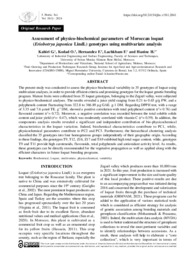Please use this identifier to cite or link to this item:
https://hdl.handle.net/11000/32394Full metadata record
| DC Field | Value | Language |
|---|---|---|
| dc.contributor.author | Hernández, Francisca | - |
| dc.contributor.author | Kabiri, Ghizlane | - |
| dc.contributor.author | Kodad, Oussama | - |
| dc.contributor.author | Zahra Lachkham, Fatima | - |
| dc.contributor.author | hanine, Hafida | - |
| dc.contributor.other | Departamentos de la UMH::Producción Vegetal y Microbiología | es_ES |
| dc.date.accessioned | 2024-07-01T10:45:52Z | - |
| dc.date.available | 2024-07-01T10:45:52Z | - |
| dc.date.created | 2024 | - |
| dc.identifier.citation | Journal of Horticultural Sciences Vol. 19 No. 1 (2024) | es_ES |
| dc.identifier.issn | 0973-354X | - |
| dc.identifier.issn | 2582-4899 | - |
| dc.identifier.uri | https://hdl.handle.net/11000/32394 | - |
| dc.description.abstract | The present study was conducted to assess the physico-biochemical variability in 35 genotypes of loquat using multivariate analyses, in order to provide efficient criteria and promising genotypes for the loquat genetic breeding program. Mature fruits were collected from 35 loquat genotypes, belonging to the Zegzel valley, were subjected to physico-biochemical analyses. The results revealed a juice yield ranging from 0.21 to 0.65 g/g FW, and a polyphenols content fluctuating from 322.8 to 366.89 µg GAE. g-1 DM. Regarding DPPH test, with a range of 3.35 and 7.6 µmol TE. g-1 DM, showed a positive correlation with total polyphenol content (r2= 0.76) and flavonoid content (r2= 0.72). Moreover, a negative correlation was recorded between the total soluble solids content and juice yield (r2=- 0.47), which was moderately correlated with vitamin C (r2= 0.59). In addition, the components analysis results revealed a significant and independent contribution of bio-physicochemical characteristics in the loquat variation. Indeed, biochemical characteristics contribute to PC1, while, physicochemical parameters contribute to PC2 and PC3. Furthermore, the hierarchical clustering analysis classified the 35 genotypes into four homogeneous groups independently of their geographic origin. According to these findings, the genotypes T9, T12, Z16, Z17 and TA9 exhibited high total sugar content, while, genotypes T9 and T11 provide high carotenoids, flavonoids, total polyphenols and antioxidant activity level. As results, these genotypes can be directly recommended for the vegetative propagation as well as applied along with the efficient characters in future loquat breeding programs | es_ES |
| dc.format | application/pdf | es_ES |
| dc.format.extent | 10 | es_ES |
| dc.language.iso | eng | es_ES |
| dc.publisher | Society for Promotion of Horticulture | es_ES |
| dc.rights | info:eu-repo/semantics/openAccess | es_ES |
| dc.rights.uri | http://creativecommons.org/licenses/by-nc-nd/4.0/ | * |
| dc.subject | Biochemical | es_ES |
| dc.subject | Loquat | es_ES |
| dc.subject | multivariate | es_ES |
| dc.subject | physicochemical | es_ES |
| dc.subject | variability | es_ES |
| dc.subject.other | CDU::6 - Ciencias aplicadas::63 - Agricultura. Silvicultura. Zootecnia. Caza. Pesca | es_ES |
| dc.title | Assessment of physico-biochemical parameters of Moroccan loquat (Eriobotrya japonica Lindl.) genotypes using multivariate analysis | es_ES |
| dc.type | info:eu-repo/semantics/article | es_ES |
| dc.relation.publisherversion | https://doi.org/10.24154/jhs.v19i1.2041 | es_ES |

View/Open:
04+KABIRI+Ghizlane+PROOF+(2).pdf
1,19 MB
Adobe PDF
Share:
.png)
